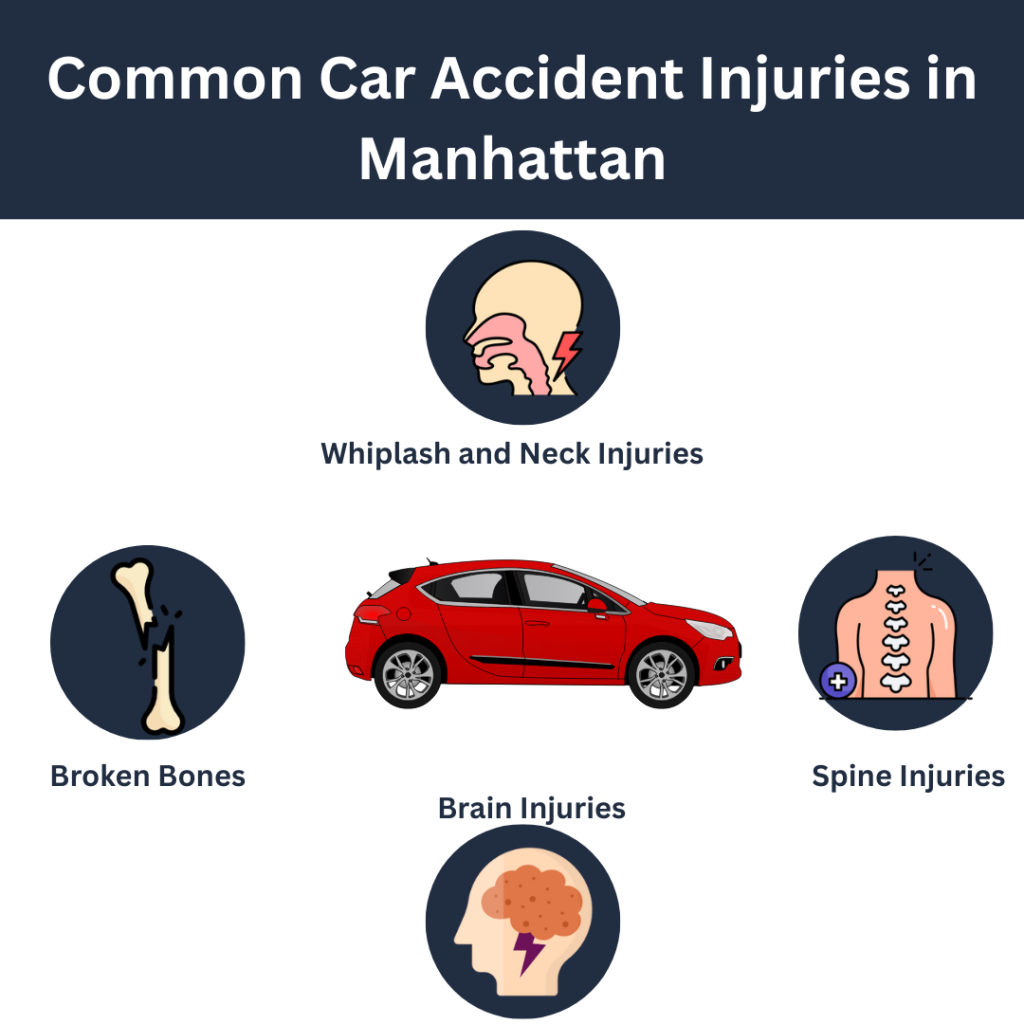Car accidents are, sadly, a part of everyday life in busy cities like Manhattan. Whether you’re behind the wheel, riding as a passenger, walking down the street, or pedaling a bike, the injuries from these accidents can vary widely—some might be minor inconveniences, while others can completely change your life. Knowing what types of injuries are most common and how to show they happened is key to standing up for your rights and getting the compensation you deserve. This guide will break it all down for you, step by step, and explain when it’s time to reach out to a Manhattan personal injury attorney for help.
Table of Contents
- Most Common Car Accident Injuries in Manhattan
- How to Prove Your Car Accident Injuries
- Why Documentation Matters
- When to Contact a Personal Injury Lawyer
- Frequently Asked Questions (FAQs)

Car accidents in Manhattan frequently lead to specific injuries because of the crowded streets filled with vehicles, pedestrians, and cyclists. Here are the most common injuries that victims often deal with:
1. Whiplash
- What it is: A neck injury that happens when the head jerks back and forth suddenly, usually during rear-end collisions.
- Symptoms: Pain in the neck, stiffness, headaches, and trouble moving your neck as usual.
- Proving it: You’ll need medical records, notes from physical therapy sessions, and diagnostic imaging like X-rays or MRIs to show the damage.
2. Fractures and Broken Bones
Here’s the deal: bone fractures are super common in high-impact collisions.
- Where they usually happen: Arms, legs, ribs, and collarbones are the most frequent spots.
- How to prove it: You’ll need X-rays, doctor’s reports, and rehab records to back it up.
3. Traumatic Brain Injuries (TBI)
- What it is: A hit to the head that messes with how the brain works, ranging from mild concussions to really serious brain damage.
- Symptoms: You might notice memory loss, feeling confused, dizziness, or even changes in your mood.
- Proving it: To show this kind of injury, you’ll need neurological exams, CT scans, and statements from expert witnesses.
4. Spinal Cord Injuries
- What it is: Damage to the spinal cord that can leave you dealing with partial or complete paralysis.
- Types: Things like herniated discs, nerve damage, or permanent mobility issues.
- Proving it: You’ll need MRI results, physical therapy records, and long-term care plans to show the full impact.
5. Soft Tissue Injuries
- What it is: Damage to muscles, ligaments, and tendons, such as sprains and strains.
- Symptoms: Swelling, bruising, and limited mobility.
- Proving it: Physical therapy notes and medical evaluations.
6. Emotional and Psychological Injuries
- What it is: Post-Traumatic Stress Disorder (PTSD), anxiety, and depression following a traumatic accident.
- Proving it: Psychiatric evaluations, therapy session notes, and medication prescriptions.
How to Prove Your Car Accident Injuries
Proving your injuries is essential to building a strong case, whether you’re filing an insurance claim or pursuing legal action. Here’s how to do it effectively:
1. Seek Immediate Medical Attention
- Go to the hospital or see a doctor right after the accident. Even if your injuries look minor, some symptoms might not show up until later.
- Hang on to copies of all your medical records, bills, and treatment plans
2. Document Everything
- Snap pictures of any visible injuries, like bruises, cuts, or swelling.
- Hold onto receipts for medications, assistive devices like crutches, and other related costs.
3. Gather Witness Statements
- Get the contact details of any witnesses who saw the accident. Their statements can back up your side of what happened.
4. File a Police Report
- Always report the accident to the police, even if it seems minor. The official report can serve as critical evidence.
5. Work with Experts
- Talk to specialists like orthopedic doctors, neurologists, or psychologists to get thorough evaluations of your injuries.
- If you end up needing to go to court, a Manhattan accident lawyer can help present this evidence effectively.
Why Documentation Matters
Documentation is the backbone of any personal injury claim. Without solid evidence, proving your injuries—and how they’ve financially impacted you—can be an uphill battle. Here’s why keeping good records is so crucial:
- Strengthens Your Case: Clear and detailed records paint a vivid picture of how bad your injuries are and directly tie them to the accident.
- Supports Compensation Claims: Thorough documentation helps figure out the total cost of damages, like medical bills, lost wages, and even pain and suffering.
- Counters Insurance Tactics: Insurers often try to minimize your injuries; having strong, well-organized proof makes it much harder for them to challenge your claim.
When to Contact a Personal Injury Lawyer

While minor accidents might only involve dealing with insurance companies, more serious cases often call for legal help. Here’s when you should think about reaching out to a top personal injury lawyer, whether they’re based in Brooklyn or Manhattan:
- Serious Injuries: If you’ve suffered fractures, TBIs, or spinal cord injuries, a lawyer can help you get the full compensation you deserve.
- Disputed Liability : When it’s unclear who’s at fault or the other side is pushing back, a skilled attorney can dig into the details and build a solid case for you.
- Lowball Offers : If the insurance company tries to offer you way less than what your claim is worth, a lawyer can step in and negotiate on your behalf.
- Complex Cases : Accidents involving multiple vehicles or rideshare drivers like Uber or Lyft can get complicated, and having specialized legal expertise can make all the difference.
For folks in Brooklyn or Manhattan, consulting a personal injury attorney in Brooklyn means you’ll have access to experienced professionals who know the local laws and courts inside and out. They’ll guide you through the process and ensure you’re not left short-changed.
Frequently Asked Questions (FAQs)
Q1: What should I do immediately after a car accident in Manhattan?
- Call 911, seek medical attention, document the scene, and notify your insurance company.
Q2: How long do I have to file a personal injury claim in New York?
- You generally have three years from the date of the accident to file a lawsuit.
Q3: Can I still recover damages if I’m partially at fault?
- Yes, under New York’s comparative negligence rule, but your compensation may be reduced based on your percentage of fault.
Q4: Why should I hire a personal injury lawyer?
- A lawyer can help gather evidence, negotiate with insurers, and represent you in court if necessary.







